Do I Need to Signal Wheb I Back Up Hawaii
FAQs - Hawaii Driver's Test

-
How many pieces of identification do I need to bring for my tests?
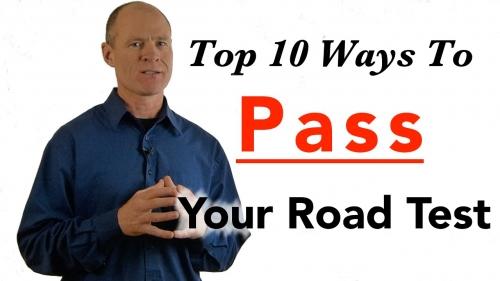 Always bring 3 pieces of identification for your driver's test.
Always bring 3 pieces of identification for your driver's test.That way, you'll have a backup in case something goes wrong.
In Hawaii, you must bring government photo identification (social security), proof of identity, age, and residency in the state.
See P. 6 for full details on identification.
-
Can I turn right on a red light?
 Yes, you can turn right on a red light unless signs prohibit it.
Yes, you can turn right on a red light unless signs prohibit it.To turn right at a red light you must first come to a complete stop at the correct stopping position.
Give way to all other road users.
When the way is clear, you can proceed.
If you're uncomfortable turning on a red light during a driver's test, you can wait for the green.
-
Do I have to parallel park?
-
How long do we stop at a STOP sign?
 You DON'T stop for a length of time at a STOP sign before proceeding.
You DON'T stop for a length of time at a STOP sign before proceeding.Rather, you bring the vehicle to a complete stop at the correct stopping postion.
After stopping at the correct stopping postion, treat the intersection as a yield, give way to all other road users, and then proceed.
-
Will the examiner tell me to move right after turning left?
 The examiner will NOT tell you to move to the right lane after turning left.
The examiner will NOT tell you to move to the right lane after turning left.You must do that automatically.
Only if the examiner tells you to turn left in the next couple of blocks do you stay in the left lane.
OR the road that you're on narrows to one lane and you have to merge left.
Slower traffic must stay right - this applies to all traffic, both in the city and on the highway.
And because you are going to be travelling the speed limit for your test, you are going to be travelling slower than the traffic flow.
-
My turns are too wide, how do I correct my wide turns?
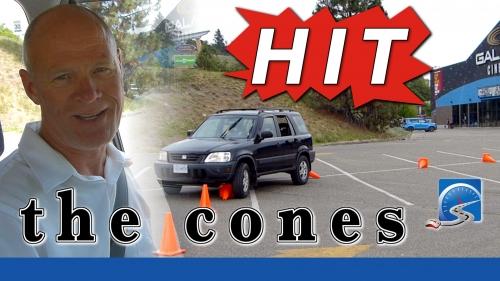 Revisit the fundamentals in the parking lot.
Revisit the fundamentals in the parking lot.Working with pylons in the parking lot will teach you mastery of the primary controls (accelerator, brake, steering, and clutch).
And more important, these slow-speed manoeuvres will teach you where your vehicle is in space and place.
In other words, where you vehicle is in relation to other road users and fixed objects.
-
Which lane do I turn into after turning right and there are parked cars in the right lane?
 When turning right and the lane is block, turn into the right lane.
When turning right and the lane is block, turn into the right lane.After you turn right, change lanes to the left lane immediately.
In the state of Hawaii, vehicles cannot park "in or so close to an intersection that your vehicle interferes with traffic."
-
Can I use a backup camera for my driver's test?
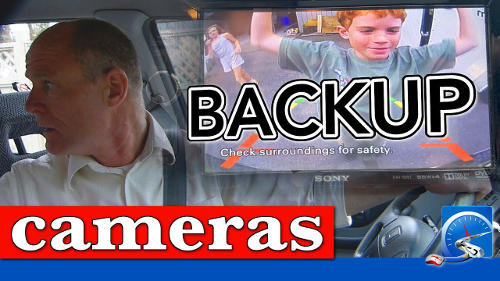 You can use a backup camera for your driver's test.
You can use a backup camera for your driver's test.You just CAN'T use it as your primary line of site.
You check the backup camera as you would check your mirrors before reversing.
Do a 360° scan around your vehicle before putting the vehicle in motion. In other words, look all around the vehicle before backing.
For the duration of your backing, you will be looking out the rear window.
-
Do I have to shoulder check for my driver's test?
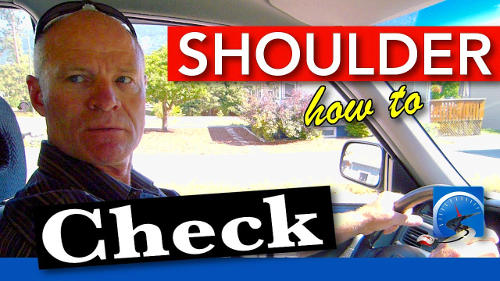 You must shoulder check 2X every time you turn, every time you move the vehicle sideways.
You must shoulder check 2X every time you turn, every time you move the vehicle sideways.If you fail to shoulder check for a driver's test, you will NOT be successful.
Or worse, you could be involved in a crash and risk injury or death!
-
Where do I stop at an intersection?
 At a controlled intersections, you stop:
At a controlled intersections, you stop:1) before the STOP line,
2) before the crosswalk line or the sidewalk.
3) If those conditions don't exist, then you stop before where the two roads meet.
In other words, just before entering the intersection.
-
Can I pull up and correct when parking?
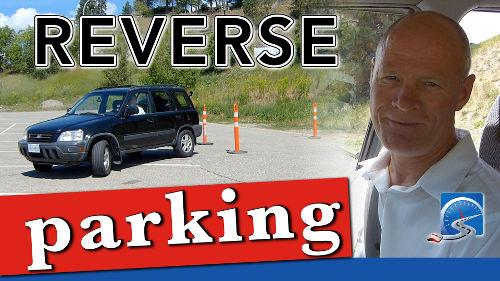 Yes.
Yes.You get one pull up on a slow-speed- or parking manoeuvre.
After the one correction you will be assigned demerits.
In some instances, it may be better to be a bit farther from the curb, or not quite centered in the parking space than risk "mucking" it up further on a correction.
-
What is the speed limit inside the city?
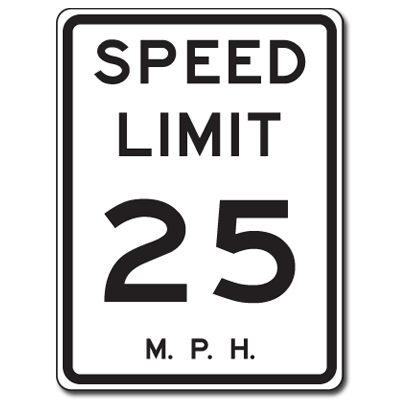 The speed limit in residential districts in Hawaii is 25mph unless otherwise posted.
The speed limit in residential districts in Hawaii is 25mph unless otherwise posted.In other words, if there aren't signs stating that the speed limit is different, then travel at 25mph.
And for the purposes of your driver's test, travel at either the posted speed limit or the flow of traffic - whichever is less.
-
Will the driving examiner try to trick me?
No.
Driving examiners know that you're nervous and they know that you don't have a high skill level.
They are not going to trick you and endanger both their own safety and that of other road users.
-
How do I pass my driver's test first time in the state of Hawaii?

 Enrol in our Pass Your Driver's Test First Time Course Package.
Enrol in our Pass Your Driver's Test First Time Course Package.This course is completely guaranteed.
If you don't pass first time, we'll refund your money and do everything in our power to help you pass your driver's test and get your license.
Also included in this great course package in the Defensive and Winter Driving Smart courses.
Even if you don't get snow and ice, the Winter Driving Smart Course will teach you how to drive safely in inclement weather (sleet, rain, fog, & glaring sun etc.)
Not only will these courses teach you to pass your driver's test first time, these will also ensure that you become a safer, smarter driver after getting your driver's license.
CLICK TO LEARN MORE!
-
What is the most common traffic sign?
 The hazard obstruction sign is the most common traffic sign on the roadway.
The hazard obstruction sign is the most common traffic sign on the roadway.Now that we've pointed it out, you'll see these traffic signs every where.
These traffic signs will prevent you colliding with a fixed object along the roadway.
-
What if I try to merge onto the freeway and other cars won't let me?
 When merging onto an interstate, you have to floor the accelerator (push it right to the bottom) to get the vehicle up to speed as quickly as possible.
When merging onto an interstate, you have to floor the accelerator (push it right to the bottom) to get the vehicle up to speed as quickly as possible.As you're coming out on the onramp and out onto the acceleration lane, pick your spot and aim for that spot.
Other drivers will help you out as much as they can.
However, know that the onus of responsibility is on the merging driver.
Pick your spot, get the vehicle up to speed, and don't hesitate.
-
Should I stop if the traffic light turns yellow?
 For the purposes of a driving test, red and yellow traffic lights are the same color.
For the purposes of a driving test, red and yellow traffic lights are the same color.In other words, if the light turns yellow and you can get the vehicle stopped, you must bring the vehicle to a stop.
Before jamming on the brakes, check to see if there is a vehicle tailgating you.
If you proceed through the intersection and the examiner looks up through the windshield and sees the traffic light turn red when you're in the intersection, you will automatically fail your driver's test.
-
Do I have to stop for emergency vehicles?
 Yes.
Yes.You must come to a stop and pull over to the shoulder of the road as soon as you see the emergency vehicle.
Only if the lights are activated and the sirens are blaring do you have to bring the vehicle to a stop.
If you're at an intersection, often times your best option is to simply stayed stopped and the emergency vehicle will find its way through the intersection.
-
Do I have to signal when parking?
 Yes.
Yes.Signal any time that you turn, or move the vehicle sideways.
And signal both when moving forward and when in reverse.
One of the fundamental components of a driver's test is to communicate effectively with other road users.
-
How much am I allowed to go over the speed limit?
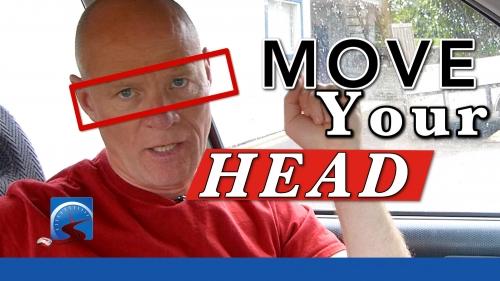 There is not a specific amount that you're allowed to go over the speed limit.
There is not a specific amount that you're allowed to go over the speed limit.However, if you consistently go 8-10mph over or under the speed limit, it's unlikely that you're going to be successful.
Your speed management is directly linked to your scanning pattern.
You should be checking your instrument panel as part of your scanning pattern every 8-12 seconds when driving.
If you aren't adjusting your speed every few moments, it tells the examiner that you don't have your scanning pattern in place.
-
Can I back into the parking space when I show up at the test centre for my driving test?
Yes.
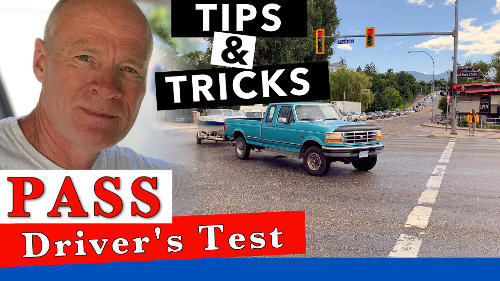 When you show up for your driver's test--unless signs prohibit this--back into the parking space.
When you show up for your driver's test--unless signs prohibit this--back into the parking space.Look for the reserved parking for the driver's tests.
Backing into the parking space will minimize the stress when starting your test.
-
Will the driving examiner do a pre-trip inspection before going on the test?
Yes.
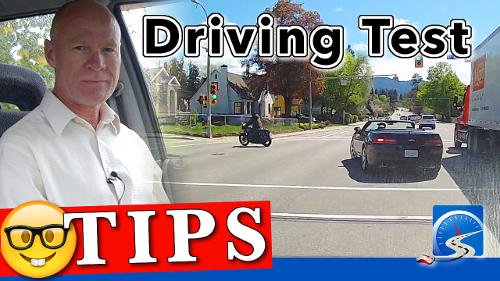 There will be a mini pre-trip inspection on your vehicle to ensure the lights work, the registration is up to date, and other functionalities.
There will be a mini pre-trip inspection on your vehicle to ensure the lights work, the registration is up to date, and other functionalities.Be sure you do a pre-trip before showing up for your test.
It's also recommended that you wash and vacuum out your vehicle.
Remember: you don't get a second chance to make a first impression.
-
What should my following distance be for the road test?
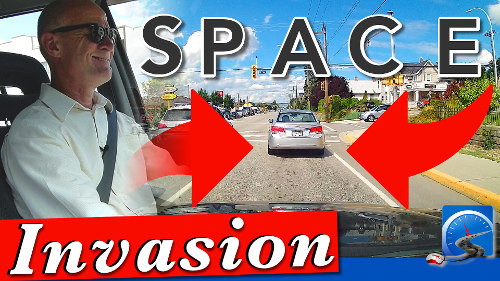 Your following distance behind other vehicles should be 2-3 seconds under ideal road conditions.
Your following distance behind other vehicles should be 2-3 seconds under ideal road conditions.If road conditions deteriorate, increase your following distance.
-
Where should I stop in traffic?
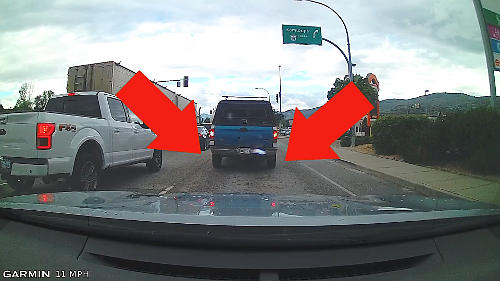 When stopped in traffic, stop so that you can see the tires of the vehicle in front making clear contact with the road surface.
When stopped in traffic, stop so that you can see the tires of the vehicle in front making clear contact with the road surface.With this landmark, you'll have approximately one vehicle length between your vehicle and the vehicle in front.
And if the vehicle in front breaks down, you can get around without reversing in traffic.
-
When should I signal for my driving test?
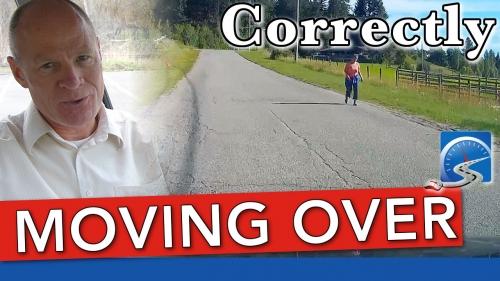 As a general rule you should signal approximatley 1/2 block before the turn.
As a general rule you should signal approximatley 1/2 block before the turn.The only time you may signal at a shorter distance is if it might cause confusion to other road users.
And before making lane changes, you must signal a minimum of 3 flashes on the turn signal before moving the vehicle.
And keep your signal on until you're completely in the other lane.
Be sure to signal any time that you turn or move the vehicle sideways - both forward and in reverse.
-
Do I have to shoulder check on left hand turns?
-
What is the speed limit on the highways?
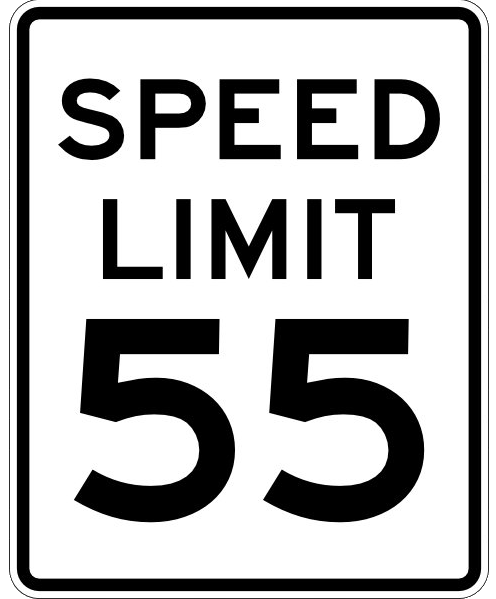 The maximum speed limit on highways in the state of Hawaii is 55 mph unless otherwise posted.
The maximum speed limit on highways in the state of Hawaii is 55 mph unless otherwise posted.This is the maximum speed limit under ideal conditions.
If the road conditions deteriorate—congestion, weather, or bright sunlight—your speed should be reduced.
-
What are some of the automatic fails on a driver's test?
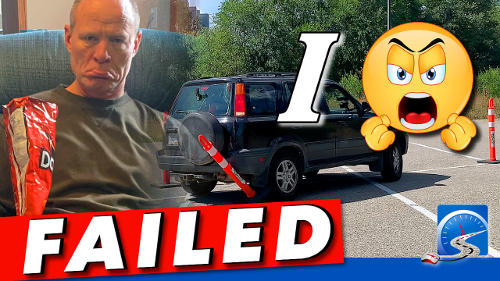 • Driving into an intersection you cannot clear.
• Driving into an intersection you cannot clear.• An action contrary to a regulatory sign.
• Speeding in a school zone when school is in session.
• Striking a fixed object.
• Driving in a manner that causes another driver to take evasive action.
• A driving action that causes the driving examiner to intervene and take control of the vehicle.
• Backing up at an intersection.

Do I Need to Signal Wheb I Back Up Hawaii
Source: https://www.smartdrivetest.com/faqs/hawaii-drivers-test